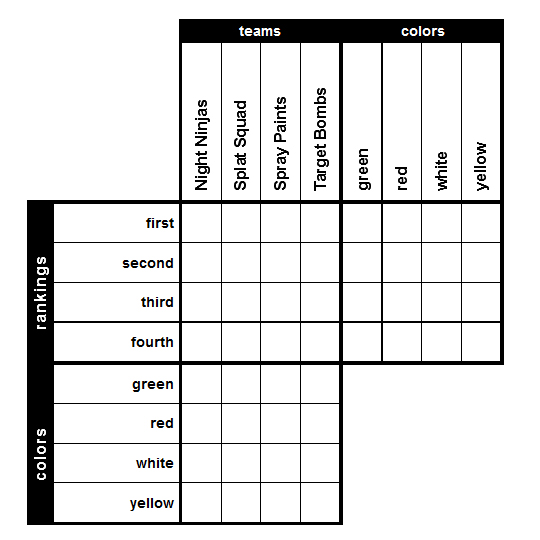When you look online for a puzzle generator to improve your Dungeons and Dragons games you will find two types of generators. In this article, we’ll discuss why we don’t prefer either of them and what we would do instead.
The first type of D&D puzzle generators are lists of free text-based puzzles. Some have been randomized with a button. So you push the button and a puzzle from the list appears. If that’s exactly what you’re looking for, then look no further.
But if you’re going to use a list, why not just show everything? That way you can scan through the list and quickly pick the puzzle that fits your story. Especially text-based puzzles are very situational. It really doesn’t help to generate a random puzzle that may not even fit your D&D game. You can simply number a list and add roll a d100.
The second type of D&D puzzle generators are logic puzzles which you can find on generic puzzle websites. For instance, this website by puzzle baron creates great logic puzzles.
The upside of using these puzzles is that their design is generally much stronger than text-based puzzles which often suffer from design errors. Players who have to sit through puzzles that don’t work will quickly start to resend them in our experience. That’s why we recommend using these types of puzzles that are based on logic. Trust us on this one, your players will be grateful you did.
The downside of using these puzzles is that they don’t fit the D&D fantasy theme. But we’re here to fix that. Here’s how.
YOU MAY ALSO LIKE:
Creating your Own Generated Puzzles for D&D in Minutes
Here’s an example of a generated puzzle from Puzzle Baron:
“The Gerber County Paintball League has just completed its 10th season. Help the league secretary finalize this year’s standings by matching each team to its color, hometown, and final ranking.”

Clues
- The “Night Ninjas” finished first.
- The white team was ranked 2 places behind the “Target Bombs”.
- The “Spray Paints” uses green paintballs.
- The green team was ranked 2 places behind the red team.
Now let’s rework it into something that fits your D&D story:
For this puzzle, we’ll say that in the local town parties heroes have a friendly competition each year. But no one remembers who came in last. And a mysterious villain is rumored to have been part of the team that came last, so you really want to know.
We’ll reskin this puzzles and change the ‘team names into party names:
- Night ninjas = The bardic beauties
- Splat squad = The knights supreme
- Spray paints = The night knives
- Target bombs = The wily wizards
And then we’ll reskin the colors to monsters that have been fought.
- Green = Undead
- Red = Aberration
- White = Beast
- Yellow = Elemental
The rankings stay the same. We substitute the names, so the clues become:
Clues
- The “Bardic Beauties” finished first.
- The party that fought the beast was ranked 2 places behind the “Wily Wizards”.
- The “Night Knives” fought undead.
- The party who fought undead was ranked 2 places behind the party who fought aberrations.
The answer to this puzzle is:
| First | Bardic Beauties | Aberration |
| Second | Wily Wizards | Elemental |
| Thrird | Night Knives | Undead |
| Fourth | Knights Supreme | Beast |
So our villain is a member of the Knights Supreme. And the players can use that clue to investigate further.
Illustrated D&D Puzzle Generators

Reskinning this computer-generated puzzle for our D&D game took about five minutes. Not bad considering how long it usually takes to create D&D puzzles.
But it’s still not an illustrated puzzle. That’s fine, you can use the theatre of the mind for a quick game. On the other hand, having illustrated puzzle pieces players can share and manipulate helps with immersion and makes your puzzle an unforgettable experience.
You can do the painstaking work of illustrating puzzles yourself but we would recommend using the illustrated puzzles from our webshop (which look much better than anything we can draw ourselves).
 You get over 200 illustrated puzzles that have been designed for fantasy games AND come fully illustrated. And some of these puzzle packs even come with instructions for quickly creating more puzzles with their illustrated pieces. So really, you can generate enough illustrated puzzles for a lifetime of DMing.
You get over 200 illustrated puzzles that have been designed for fantasy games AND come fully illustrated. And some of these puzzle packs even come with instructions for quickly creating more puzzles with their illustrated pieces. So really, you can generate enough illustrated puzzles for a lifetime of DMing.
A single illustrated puzzle pack costs $4.99 and contains an average of about 30 puzzles. If you want all 200+ puzzles there’s the Puzzle Bundle at $19.99. In this article, we calculated that you pay $0.037 per puzzle. Unless the designer recently added more puzzles to the pack, then you would pay even less per puzzle. GET THE PUZZLE BUNDLE HERE.
Sure, there’s free stuff. But you get what you pay for. In our opinion, these are well worth the money.
Dark Ulf is the founder and editor of DNDpuzzles.com. When not writing for DNDpuzzles he travels the multiverse and destroys demons with a crossbow in one hand and a crossword in the other.
We hope this site inspires you to put more puzzles into your D&D games.


